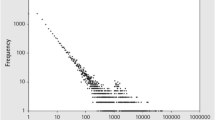Abstract
Consider a set of elements which we want to rate using information about their bilateral relationships. For instance sports teams and the outcomes of their games, journals and their mutual citations, web sites and their link structure, or social alternatives and the tournament derived from the voters' preferences. A wide variety of scoring methods have been proposed to deal with this problem. In this paper we axiomatically characterize two of these scoring methods, variants of which are used to rank web pages by their relevance to a query, and academic journals according to their impact. These methods are based on the Perron–Frobenius theorem for non-negative matrices.

Similar content being viewed by others
Notes
An anonymous referee suggested Saaty's (1980) work on the analytic hierarchy process in the context of multicriteria decision making as another successful application of the Perron–Frobenius theory.
Readers interested in learning some of the subtle properties of this procedure can consult Merlin and Saari (1996).
Note that in this context, A is the transpose of the adjacency matrix of the WWW graph.
Note, however, that this restriction should not be applied for ranking journals, since self-references do matter. See Palacios-Huerta and Volij (2002).
That every irreducible stochastic matrix has a unique stationary distribution is a standard result in finite Markov Chain theory. See Kemeny and Snell (1976).
This interpretation is based on Lemma 3.1 in Freidlin and Wentzell (1998).
Note that since A is irreducible, this ratio is well-defined.
References
Arrow KJ (1963) Social Choice and Individual Values, 2nd ed, Yale University Press, New Haven
Brin S, Page L (1998) The anatomy of large-scale hypertextual web search engine. Computer Networks 30(1-7):107–117
Chakrabarti S, Dom B, Gibson D, Kleinberg J, Kumar R, Raghavan P, Rajagopalan S, Tomkins A (1999) Hypersearching the web. Scientific American (June issue)
Conner GR, Grant CP (2000) An extension of Zermelo's model for ranking by paired comparisons. Eur J Appl Math 11:225–247
Daniels HE (1969) Round-robin tournament scores. Biometrika 56:295–299
David HA (1987) Ranking from unbalanced paired-comparison data. Biometrika 74:432–436
David HA (1988) The Method of Paired Comparisons, 2nd ed, Charles Griffin and Company, London
Elo AE (1978) The Rating of Chess Players, Past and Present. Arco Publishing Inc
Freidlin MI, Wentzell AD (1998) Random Perturbations of Dynamical Systems, 2nd ed, Springer, Berlin Heidelberg New York
Henriet D (1985) The Copeland choice function: an axiomatic characterization. Social Choice and Welfare 2:49–63
Herings J-J, van der Laan G, Talman D (2001) Measuring the power of nodes in digraphs. Discussion paper
Kano M, Sakamoto A (1985) Ranking the vertices of a paired comparison digraph. SIAM Journal on Algebraic and Discrete Methods 6:79–92
Keener JP (1993) The Perron–Frobenius theorem and the ranking of football teams. SIAM Review 35:80–93
Kemeny JG, Snell JL (1976) Finite Markov chains. Springer, Berlin Heidelberg New York
Kendall MG (1955) Further contributions to the theory of paired comparisons. Biometrics 11:43–62
Kleinberg J (1999) Authoritative sources in a hyperlinked environment. J ACM 46:604–632
Laslier J (1997) Tournament solutions and majority voting. Springer, Berlin Heidelberg New York
Levchenkov VS (1995) Self-consistent rule for group choice. I: Axiomatic approach. Discussion Paper 95–3, Conservatoire National des Arts et Métiers
Merlin V, Saari DG (1996) Copeland method I: dictionaries and relationships. Economic Theory 8:51–76
Moon JW (1968) Topics on tournaments. Holt, Rinehart and Winston, New York
Moon JW, Pullman NJ (1970) On generalized tournament matrices. SIAM Review 12:384–399
Moulin H (1988) Axioms of cooperative decision making. Cambridge University Press, Cambridge, UK
Page L, Brin S, Motwani R, Winograd T (1999) The PageRank citation ranking: Bringing order to the web. Technical report, Stanford University
Palacios-Huerta I, Volij O (2002) The measurement of intellectual influence
Pinski G, Narin F (1976) Citation influence for journal aggregates of scientific publications: theory, with applications to the literature of physics 12:297–312
Rubinstein A (1980) Ranking the participants in a tournament. SIAM J Appl Math 38:108–111
Saari DG (2001) Decisions and elections: explaining the unexpected. Cambridge University Press
Saaty TL (1980) The analytic hierarchy process: planning, priority setting, resource allocation. McGraw Hill
Sen A (1970) Individual choice and social welfare. Holden Day
Thomson W (2000) Consistent allocation rules. Mimeo, University of Rochester
van den Brink, Gilles R (2000) Measuring domination in directed networks. Soc Networks 22:141–157
Wei T (1952) The algebraic foundation of ranking theory. Ph.D Thesis, Cambridge University
Zermelo E (1929) Die Berechnung der Turnier–Ergebnisse als ein Maximalproblem der Wahrscheinlichkeitsrechnung. Math Z 29:436–460
Author information
Authors and Affiliations
Corresponding author
Additional information
We thank Herbert A. David for his insightful comments and an anonymous referee for several useful references.
Rights and permissions
About this article
Cite this article
Slutzki, G., Volij, O. Scoring of web pages and tournaments—axiomatizations. Soc Choice Welfare 26, 75–92 (2006). https://doi.org/10.1007/s00355-005-0033-7
Received:
Accepted:
Published:
Issue Date:
DOI: https://doi.org/10.1007/s00355-005-0033-7




